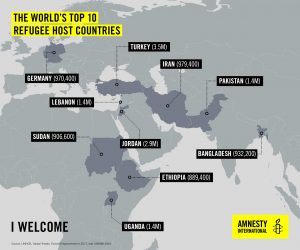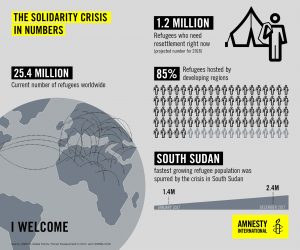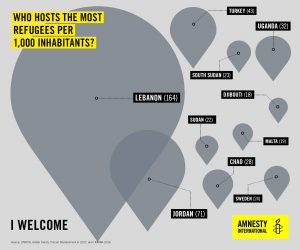Here are the facts:
- There are 68.5 million people displaced worldwide.
- 25.4 million are refugees; 3.1 million are asylum-seekers
- 40 million are internally displaced – meaning they currently still live in their native country, but have had to shift from their home region to another
- 85% of all refugees move to developed countries
- 57% of refugees today live in South Sudan, Afghanistan, and Syria
- There are 10 million stateless people – this means 10 million people around the world have no nationality, no citizenship, and no rights
- 44,400 people flee every day
- 45% of the Syrian population (11 million) are currently displaced
- The world’s largest refugee camp currently holds 329,000 people in Dadaab, Kenya
- 51% of refugees worldwide are under the age of 18
- 3 million refugees have settled in the United States since 1975
Types of displaced peoples:
- Refugees – people who escape natural or human-made disasters such as flood and drought or persecution based on race, religion, politics, or association with a particular group
- Asylum seekers – a type of refugee who has fled to another country, but has yet to receive refugee status
- Internally displaced peoples – people who migrate to another region within their home country
- Stateless persons – people who have no nationality and do not belong to either their home country or the country in which they are seeking refuge
- Returnees – former refugees who return after their time in exile
 The United Nations High Commissioner for Refugees (UNHCR) employs 16,765 people around the world, and is currently working in 138 countries. But despite the expansive presence of the UNHCR, and the amount of money the United Nations uses towards aiding displaced peoples, it’s not enough. Refugee camps around the world are thought to be mini sanctuaries for those seeking asylum; people often think refugees living in camps are much better off, and have escaped to a better life. But the truth of the matter is that millions of refugees are living in abysmal conditions. When they first fled and began to settle in northern Libya, Eritrean refugees had many resources. The UNHCR brought doctors, medications, food, blankets, and other supplies. But not too soon after, resources ran out, the doctors went home because they were no longer able to be paid, and the medications were taken with them. Because of this, there has been an outbreak of tuberculosis, and because the refugees live in small cramped spaces, illnesses such as these spread like wildfire.
The United Nations High Commissioner for Refugees (UNHCR) employs 16,765 people around the world, and is currently working in 138 countries. But despite the expansive presence of the UNHCR, and the amount of money the United Nations uses towards aiding displaced peoples, it’s not enough. Refugee camps around the world are thought to be mini sanctuaries for those seeking asylum; people often think refugees living in camps are much better off, and have escaped to a better life. But the truth of the matter is that millions of refugees are living in abysmal conditions. When they first fled and began to settle in northern Libya, Eritrean refugees had many resources. The UNHCR brought doctors, medications, food, blankets, and other supplies. But not too soon after, resources ran out, the doctors went home because they were no longer able to be paid, and the medications were taken with them. Because of this, there has been an outbreak of tuberculosis, and because the refugees live in small cramped spaces, illnesses such as these spread like wildfire.
The situation in Libya is but one example of the struggles refugees face. When fleeing, many refugees lose contact with their families, become human trafficking victims, or are exploited in informal labor arrangements. More than 300,000 children migrated without their families in 2017. But as the number of displaced peoples grows, so does the need for monetary support. The country of Syria has disbursed the largest number of refugees in the shortest amount of time, while the Democratic Republic of the Congo (DRC) illustrates how refugees can migrate over a series of decades. Like many countries in Africa, many of the Congolese were displaced internally, trying to escape from war and civil unrest, but many were inevitably forced to flee into East Africa and other parts of the world. Refugees from the DRC have been fleeing for more than twenty years.
World Refugee Day is held on June 20th every year. On December 4, 2000 the United Nations General Assembly decided the 17th of June would be commemorated in honor and respect of the continuously growing number of refugees and peoples displaced around the world. This was later changed to coincide with Africa Refugee Day on June 20. World Refugee Day is observed by numerous countries around the world in an attempt to bring attention to the millions of refugees and other peoples displaced because of conflict, war, and/or persecution, and on the 20th of every year, people around the world come together to bring awareness to refugees’ stories — the challenges they face, the places they reside, and the communities they call home.
Past themes from World Refugee day have covered topics relating to families being torn apart, how refugees find a new sense of home in a foreign land, and how/if countries have programs and services in place for the protection of displaced peoples. In 2016, the United Nations Refugee Agency began the #WithRefugees campaign in an attempt to show support for the growing number of displaced peoples by taking action to ensure refugee children have access to education, families have access to safe and secure shelters, and all refugees have the opportunity to develop skills or find work and provide for their families.
Numerous non-profits and non-governmental organizations like Amnesty International and the Red Cross International have been trying to offset the challenges refugees face. But as the population of displaced peoples worldwide continues to grow, resources dry up, and even those projects funded by the United Nations are not enough. In a world where war and conflict seem never-ending, we need to be thinking more seriously about how we can make conditions for refugees more humane and sustainable.
_________________________________________________
Other Resources
Connable, Ben. From Negative to Positive Stability: How the Syrian Refugee Crisis can Improve Jordan’s Outlook. Santa Monica, RAND, 2015.
Fleming, Melissa. A Hope More Powerful than the Sea: One Refugee’s Incredible Story of Love, Loss, and Survival. New York, Flatiron Books, 2017.
Hammerstad, Anne. The Rise and Decline of a Global Security Actor: UNHCR, Refugee Protection, and Security. Oxford, Oxford University Press, 2014.
Kassa, Derese G. Refugee Spaces and Urban Citizenship in Nairobi: Africa’s Sanctuary City. Lanham, Lexington Books, 2019.
Kingsley, Patrick. The New Odyssey: the Story of the Twenty-first-century Refugee Crisis. New York, Liveright Publishing Corporation, 2017.
Maina, Andrew. Is My Claim Meritorious?: Congolese Experience of the Refugee Status Determination Process in Kenya. Danish Refugee Council, Great Lakes Civil Society Project, 2014.
McDonald-Gibson, Charlotte. Cast Away: True Stories of Survival from Europe’s Refugee Crisis. New York, New Press, 2016.
McPherson, Stephanie Sammartino. The Global Refugee Crisis: Fleeing Crisis and Violence. Minneapolis, Twenty-First Century Books, 2019.
Ribas Mateos, Natalia. Migration, Mobilities and the Arab Spring: Spaces of Refugee Flight in the Eastern Mediterranean. Northampton, Edward Elgar Publishing, 2016.
Sasikumar, Karthika, and Danijela Dudley. Political and Military Sociology: the European Refugee Crisis. London, Routledge, 2018.
Wilmer, S.E. Performing Statelessness in Europe. Cham, Palgrave Macmillan, 2018.
Woolley, Agnes. Contemporary Asylum Narratives: Representing Refugees in the Twenty-first Century. New York, Palgrave Macmillan, 2014.
_________________________________________________
*Statistics and definitions courtesy of the United Nations. https://www.unhcr.org/
*Diagrams courtesy of Amnesty International.
For more information on what is being done around the globe, visit the following sites
Amnesty International https://www.amnesty.org/en/what-we-do/refugees-asylum-seekers-and-migrants/global-refugee-crisis-statistics-and-facts/
GlobalGiving https://www.globalgiving.org/world-refugee-day/
MercyCorps https://www.mercycorps.org/articles/worlds-5-biggest-refugee-crises
American Red Cross https://www.redcross.org/about-us/our-work/international-services/migration-and-refugee-crisis.html



Comments are closed.